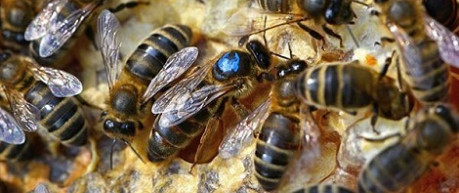Monday 22nd May 2023, 9:00am
Honey bee genetic data resource has potential to cut research costs and help scientists identify key genes for healthy breeding.

Researchers have created a resource that allows the scientific community to better understand the genetic diversity of honey bees.
The resource, called AmelHap (a honey bee HapMap), can be used to help identify genes associated with traits such as disease resistance and honey production. It can also be used to infer missing information in data from whole-genome analyses, driving down research costs.
AmelHap was developed to help scientists identify the genetics of native strains of bees and understand the extent of breeding between different strains.
The international collaboration was led by researchers at the Roslin Institute and Beebytes Analytics, a community interest company based at Roslin Innovation Centre specialising in honey bee genetics. The research processed genetic data for over 1,300 honey bees sampled across 19 countries, and an online community has been established for AmelHap, allowing researchers to contribute to its ongoing development with data from around the world.
As the resource grows, it can support research aiming to gain a better understanding of how honey bees have adapted to different environments. The dataset is available online, where scientists can download it and use it to inform breeding strategies and support the conservation of native strains, while reducing the risk of introducing parasites and diseases from imported strains. AmelHap can be compared with the Human HapMap project, a collaborative effort to identify genetic variations in human populations to understand the genetic basis of complex diseases.
This research was published in Nature Scientific Data, and was carried out in collaboration with colleagues from the University of the Basque Country in Spain, and the National Research Institute for Agriculture, Food and the Environment (INRAE) in France.
"This resource lets us look across all the genetic variations of all the different honey bees that we've gathered from Europe and beyond. Instead of just assuming whether a bee is native or not based on its appearance and sampling location, researchers can now analyse honey bees and compare them against the data we have gathered. AmelHap will be an important resource for a range of studies in the future."
Dr David Wragg, Research Fellow and co-founder of Beebytes Analytics"Honey bees are believed to have arrived on the British Isles after the retreat of the last ice age and are just one of more than 270 species of native bee. Effectively managed as livestock, they are a unique model organism for scientific study that could benefit other pollinating insects."
Dr Mark Barnett, Scottish Expert Beemaster and co-founder of Beebytes AnalyticsArticle source: Roslin Institute